Exercises (2276)
Badminton: Marathonspiel
Forms of play / exercises
Groups of 2

Two players pass the shuttle to each other as often as possible in a given time and count the shuttle changes. All pairs are the same distance apart. The pair with the highest number of shuttle changes wins the game.
Per participant:
1 badminton racket
Per group:
1 shuttle
Badminton: Round robin
Forms of play / exercises
Group work

4-10 players play on each pitch, evenly distributed over both halves of the pitch. The foremost players on both sides are in the field and pass the shuttle to each other. The remaining players wait in single file behind the playing field until it is their turn. After each stroke, the respective player runs to the opposite side, lines up at the back and waits for his next stroke. The player at the front of the column becomes the new batter. If a player makes a mistake (hit out or ball falls to the ground in their own court), they are eliminated from the game. The last 2 players play a final game to 3 points.
Variant:
Ejected players have the chance to return to the game by being eliminated by the player who threw them out (i.e. last touch of the ball before the error).
Per participant:
1 badminton racket
Per court:
1 shuttle
Badminton: Change hands
Forms of play / exercises
Groups of 2
Passing game in teams of two; change of hands after each shot. Who makes fewer mistakes?
Per participant:
1 badminton racket
Per group:
1 shuttle
Badminton: Game
Forms of play / exercises
Group work

Single (group of 2) or double game (group of 4) for a certain number of points (e.g. 10). If the group size is uneven (e.g. 3 participants), one player enjoys a break, whereby the duration of the game is reduced (e.g. 7 points) so that waiting times are shortened.
Additional task Strengthening:
After each game, the loser completes a strength exercise: 5x push-ups plus stretch jump (burpee)
1 badminton net
2 badminton support poles
2-4 badminton rackets
1 badminton shuttle
Badminton: Relay race
Forms of play / exercises
Group work
Pendulum relay with several teams (participants of the teams are evenly distributed on markers approx. 20 metres apart). Each team has a racket and a shuttle. The first runner from each team must balance the shuttle with the racket to the other side while running and then hand the racket and shuttle to the next runner. If the shuttle falls down, it must be picked up and placed back on the racket. Each player completes two runs (i.e. the players are in the same position at the end as at the beginning).
Variant:
The players must hit the shuttle at least 10 times in the air during the race.
Per participant:
1 badminton racket
Per group:
1 shuttle
Badminton: Techniktraining
Forms of play / exercises
Groups of 2


Explain the stroke terms clear, lob, drop, net drop, drive and smash on the flipchart (see image 1/2).
Two players stand opposite each other on either side of the net and perform various stroke exercises:
- Clear - Clear
- Drop - Underhand Clear
- Net Drop - Net Drop (play exclusively in the court in front of the service line)
- Drive - Drive
- Clear - Smash
Handling position:
- Rush grip (frying pan) for beginners
- Forhand / backhand grip offers more options
Per participant:
1 badminton racket
Per group:
1 badminton shuttle
1 flipchart (stroke types)
Badminton: Exercises for beginners
Forms of play / exercises
Individual work

Shuttle juggling in various positions (smooth transitions):
- standing
- walking
- sitting
- on your stomach
- on your back
- running
- walking backwards, etc.
Per participant:
1 badminton racket and 1 shuttle
Badminton: Changeover
Forms of play / exercises
Groups of 2
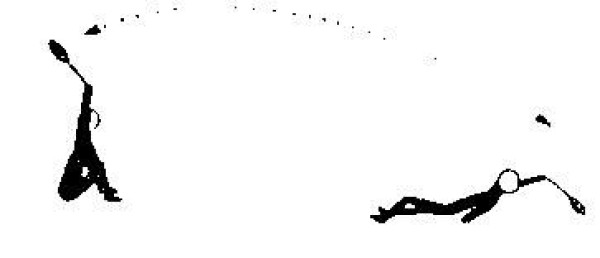
Passing game in teams of two; the players sit opposite each other and pass the shuttle to each other. From this position, the players take it in turns to lie on their backs without interrupting the rally.
Per participant:
1 badminton racket
Per group:
1 shuttle
Balance artist
Coordination exercises
Individual work

The participant tries to maintain balance on a balance board (feet parallel or orthogonal to the roller). The exercise can be made more difficult by doing squats or juggling balls at the same time. Advanced users can also stand on the balance board on one leg. For beginners, a friend can provide assistance or you can position yourself in front of a wall that you can support yourself against.
► Balance ability
1 balance board
3 tennis balls
Balance artist
Coordination exercises
Individual work

Stand on the narrow side of the long bench on one leg and perform half and full turns without falling off the bench. After a few attempts, change the standing leg.
► Balance ability
1 Longbank
Balance artist
Coordination exercises
Individual work
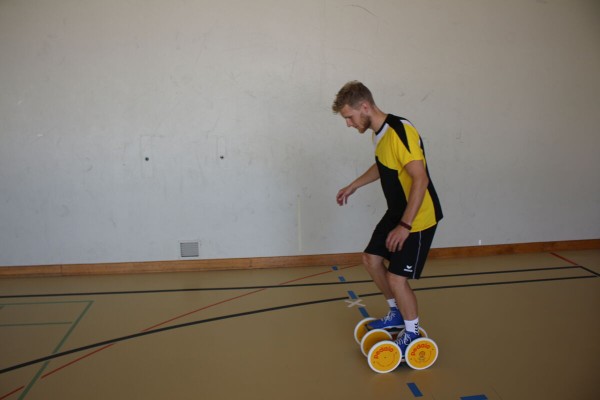
Running a certain distance standing on a running board with wheels.
Difficulty:
Running backwards.
Variant:
Race between group members over a specified distance. On contact with the ground, the respective participant must move back by 2 metres.
► Balance ability
1 footboard with wheels
Balance artist
Coordination exercises
Individual work

Sit on the exercise ball, raise your arms and legs slightly and keep your balance (floating position).
Variant:
Take a kneeling or even standing position on the exercise ball.
►Balance ability
1 exercise ball
Balance artist
Coordination exercises
Individual work

The participant positions themselves in front of the long bench, fixes a point on the ceiling or floor and quickly rotates around their own axis 5-10 times before balancing over the long bench immediately afterwards.
► Orientation skills, balance skills
1 Longbank
Balancieren
Parkour
Partner work
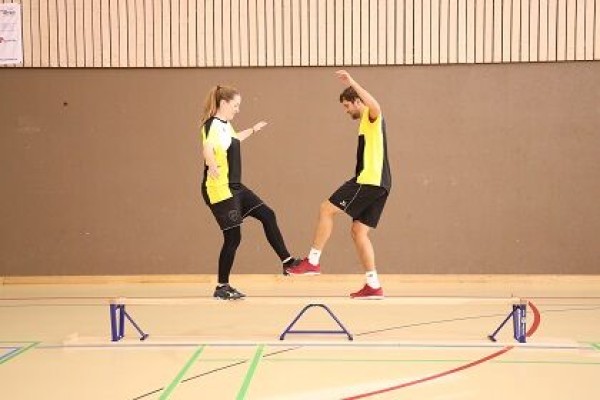

Two participants stand on one leg on the narrow side of a long bench and face each other head-on (stand on a wall, ground line or other elevation ►outdoor version), pressing the inside of the foot of the free leg (also possible with the outside edge of the foot) against the foot of the other person, then trying to push their partner off the bench without losing their balance. Switch legs from time to time.
1 long bench
Indoor post setup:
Narrow side of the long bench points upwards.
Outdoor:
Narrow wall, ground line or other elevation.
Balancieren
Parkour
Individual work
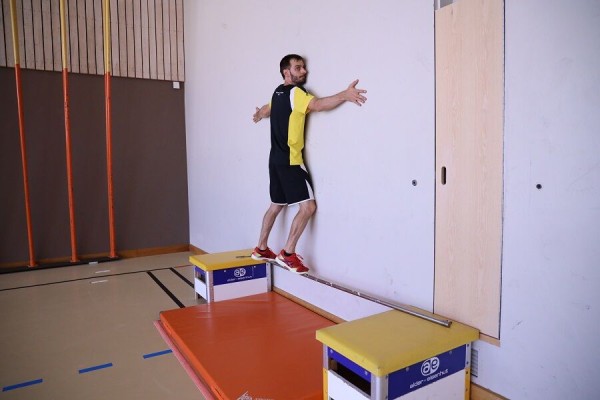
Balance over the horizontal bar from one side of the vaulting box to the other
.2 vaulting boxes
1 horizontal bar
1 soft mat (small)
Post structure:
Place two vaulting boxes (2 elements each incl. top section) on a wall approx. 1.5m apart, place a horizontal bar over the two top sections.
Balancieren
Parkour
Individual work

Balance over the horizontal bars from box to box top.
Variations:
Integrate jumps;
Include 180 and 360 degree turns.
outdoor:
Balance on a narrow ledge and incorporate jumps and 180 or 360 degree turns.
3 vaulting box (upper parts)
2 horizontal bars
Post structure indoor:
Three vaulting box upper parts are placed on the floor and connected with horizontal bars.
outdoor:
a narrow bar/raiser.
Balancieren
Parkour
Individual work
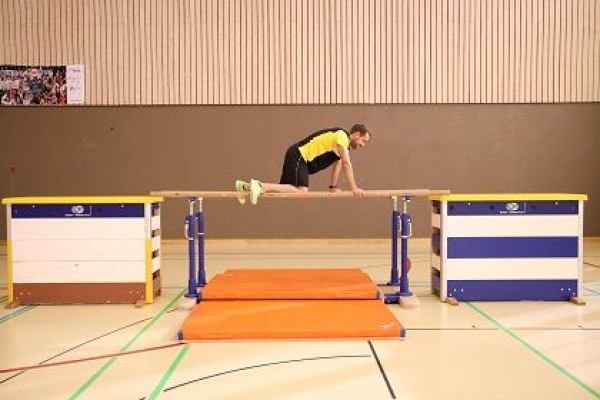
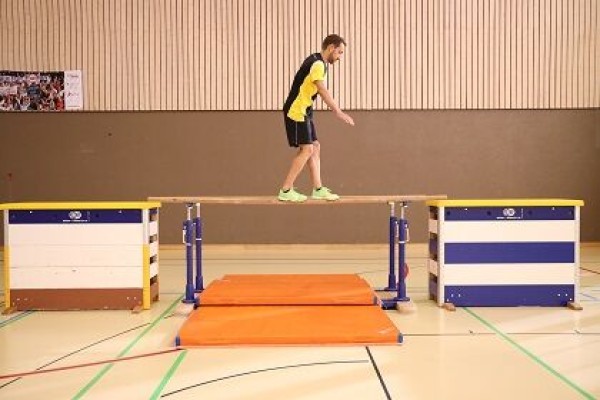
Moving from one vaulting box to the other by crossing the bar on all fours or in an upright position.
1 parallel bars
2 vaulting boxes
2-4 soft mats (small)
Post setup:
Set up two vaulting boxes with a parallel bar in between (lengthwise).
Balancieren
Parkour
Individual work
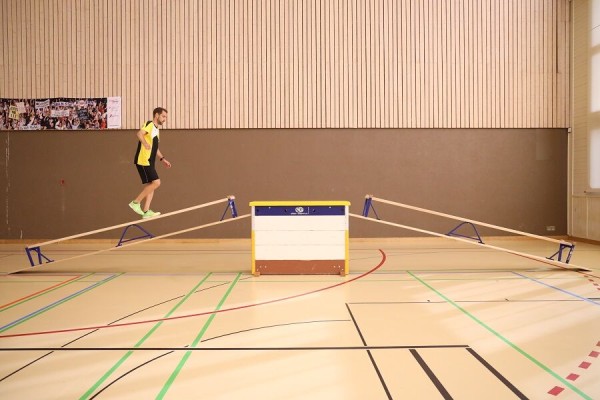
Balancing over the long benches and the vaulting box from one side to the other.
Variations:
Change direction of movement (fw./rw.);
Change type of movement (upright/on all fours);
Change speed.
outdoor:
Walk along a pole or narrow wall in a four-foot stance.
Variant:
Walk backwards.
1 vaulting box ► indoor version
2 long benches ► indoor version
Indoor post setup:
Hook two long benches with the narrow side facing up at both ends of a vaulting box.
outdoor:
Pole or narrow wall.
Balancieren
Parkour
Individual work


Balancing over long benches and medicine balls from one side to the other.
Variations:
Jumping with one leg from ball to ball;
Jumping with 180 degree turns from ball to ball.
outdoor:
Standing frontally on the pole (e.g. barrier, fence) and balancing. The second person provides assistance so that no one falls.
Variations:
Stand sideways;
Walk on the pole.
2 long benches
3 medicine balls
Indoor set-up:
Three medicine balls lie between two upturned long benches (narrow side facing upwards) at a slight distance from each other.
Outdoor:
A very narrow surface.
Capturing the ball
Fighting and roughhousing games
Partner work

Two participants grab a ball with both hands. The participants try to snatch the ball from their opponent. Whoever captures the ball wins.
1 ball (e.g. volleyball, softball, handball, basketball, football)
Capturing the ball
Fighting and roughhousing games
Partner work
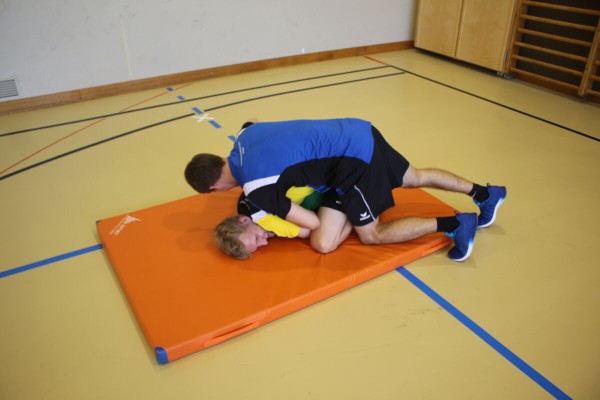
One participant tries to shield a ball as well as possible from their opponent (e.g. burying the ball underneath them in a four-footed stance). The opponent tries to steal/steal the ball from them.
Variant:
Stop time until the ball is successfully captured or set a time limit for the attempt.
1 soft mat (small) ►indoor version
1 ball (e.g. volleyball, softball, handball, basketball, football)
1 rash tent sheet ►outdoor version
1 stopwatch ►variations of the exercise
ball catcher
Coordination exercises
Individual work
One participant stands on the slackline, the partner on the floor. Now try to pass the ball back and forth as often as possible without the participant on the slackline falling off it.
Heavy:
Both participants stand on the same or different slacklines and try to pass the ball back and forth as often as possible.
1 Slackline
Ball artist
Coordination exercises
Individual work
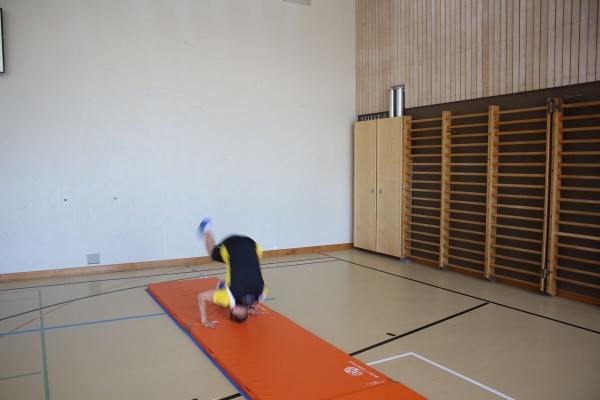
The participant stands at the beginning of the row of mats and throws a soft/foam/volleyball high into the air. The participant then performs a forward roll and tries to catch the ball directly out of the air while standing.
Variant:
Roll backwards; two rolls etc.
►Orientation skills, differentiation skills
4 soft mats (small) ► indoor version
1 soft/foam/volleyball
Turf pitch ► outdoor version
Indoor post set-up:
Using small soft mats to form a row of mats.
Bench push
Fighting and roughhousing games
Partner work
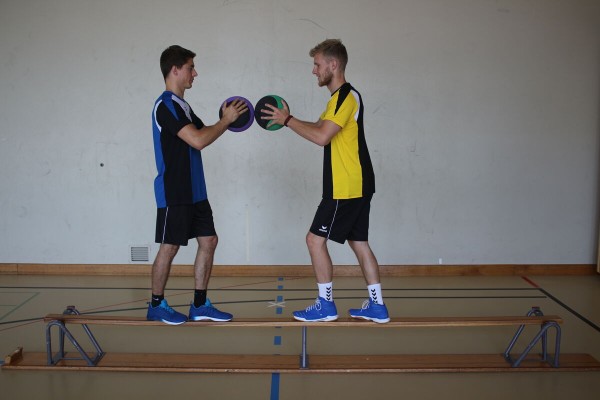
Two participants stand opposite each other on the narrow side of a long bench (possibly raised using Swedish boxes) and each hold a medicine ball in their hands. The participants try to push each other off the long bench with the medicine balls. Whoever touches the ground first loses.
1 long bench
2 medicine balls
2 vaulting boxes ►Variation/making the exercise more difficult (post set-up)
Post set-up:
Position the long bench with the narrow side facing up (possibly hang it on the side of two vaulting boxes so that the long bench is raised off the ground).
Basketball
Games / Tournament
Game idea:
Quick and accurate passing of the ball in front of the opponent's basket and a final attack with a direct throw into the basket or via the board. The opposing team has the task of fending off the attack, gaining possession of the ball and going on the attack itself.
Scoring points:
A basket from the field counts as 2 points. A successful shot from beyond the 3-point line scores 3 points. A sunk free throw scores 1 point.
Court:
Basketball court (15mx28m), basket with rebound board. Basket height 3.05m
Number of participants:
5 against 5
Game rules:
The game starts with a bouncing ball in the centre of the court. If the ball leaves the court, the opposing team returns it into play with a throw-in from the edge of the court. After a point is scored, the right to attack changes and the ball is brought back into play with a throw-in from the baseline on the side of the scorer (except in the case of several free throws). If the attacking team has crossed the halfway line and is in the opponent's half of the court, it may not return the ball to its own half.
The game is played largely without physical contact. A maximum of one step may be taken with the ball in the hands without bouncing or passing (step fault). So-called doubles are also prohibited (catch-bounce-catch-bounce). Star steps are permitted with the ball in the hands (one leg remains firmly on the ground). If the shooter is obstructed, they are allowed free throws (2 inside or 3 free throws outside the 3-point line).
There are several rules for time violations in basketball. For example, you have a maximum of 24 seconds for an attack, whereby you must have crossed the centre line within 8 seconds. No player on the team in possession of the ball may stay in the opponent's restricted zone (trapezoid between the baseline and the free-throw line) for longer than 3 seconds. You have 5 seconds to get the ball back into play after winning a point or leaving the court.